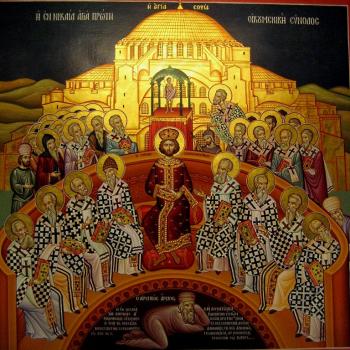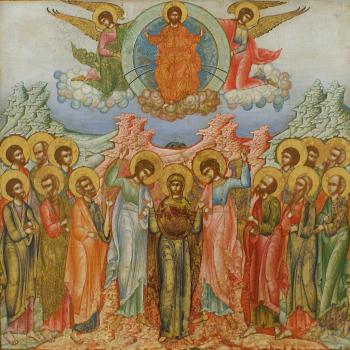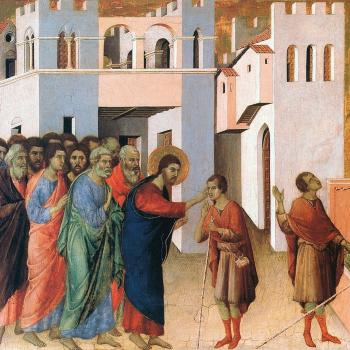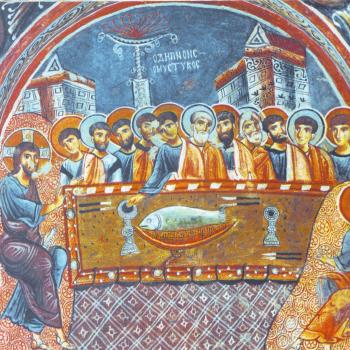
One of the most famous post-resurrection stories of Jesus is when he asked Peter three times whether or not Peter loved him:
When they had finished breakfast, Jesus said to Simon Peter, “Simon, son of John, do you love me more than these?” He said to him, “Yes, Lord; you know that I love you.” He said to him, “Feed my lambs.” A second time he said to him, “Simon, son of John, do you love me?” He said to him, “Yes, Lord; you know that I love you.” He said to him, “Tend my sheep.” He said to him the third time, “Simon, son of John, do you love me?” Peter was grieved because he said to him the third time, “Do you love me?” And he said to him, “Lord, you know everything; you know that I love you.” Jesus said to him, “Feed my sheep (Jn. 21:15-17 RSV).
This story is connected to a greater story of how and when several of Jesus’ disciples met with Jesus that day and were fed by him. Peter and others were out in a boat, trying to fish by catching nothing. Then they saw Jesus (not recognizing him) on the beach, with Jesus asking them if they had any fish. When they told him they had not, Jesus told them to cast their nets to the right. Following Jesus’s advice, they caught more fish than they could take up into their boat. Then John noticed that the man on the beach was Jesus; Peter, who had been naked, quickly puts on clothes and jumps into the sea, while the rest of the disciples bring the ship in with their haul:
When they got out on land, they saw a charcoal fire there, with fish lying on it, and bread. Jesus said to them, “Bring some of the fish that you have just caught.” So Simon Peter went aboard and hauled the net ashore, full of large fish, a hundred and fifty-three of them; and although there were so many, the net was not torn. Jesus said to them, “Come and have breakfast.” Now none of the disciples dared ask him, “Who are you?” They knew it was the Lord. 13 Jesus came and took the bread and gave it to them, and so with the fish. This was now the third time that Jesus was revealed to the disciples after he was raised from the dead (Jn. 21:9-14 RSV).
The story of Jesus feeding the disciples should be seen as the foundation by which Peter is charged to feed Jesus’ flock. Just as Jesus fed them, Peter finds it has become his duty to feed the church. At first glance, it might seem that we have a simple historical account. But upon further examination, several questions arise, such as, where exactly did Jesus get the bread and fish which he served the disciples, or what happened to the fish which the disciples had brought to the shore? Or, we can raise a theological question. Does not Jesus represent the human ideal, that is human perfection? Does not Scripture itself suggest that in its perfect, pre-fallen (and antediluvian) state, its diet was strictly vegetarian (if not vegan)? Why, then, would Jesus give out fish to eat, thereby serving a meal which runs against such a perfect state?
These issues emerge when the story is taken at face value; but Scripture is not always meant to be taken at face value. Much of what is in Scripture has symbolic value, presenting something more than meets the eye. Sometimes, it is done in and through historical incidents, establishing symbols through them, but sometimes it is through the creative use of symbols, historical narratives are created, presenting not positivistic history but a spiritual history, telling something which happened through such symbols. Why? Because symbols present greater theological and spiritual insight, allowing us to participate in the truth of the event itself, beyond the confines of time and space. Origen pointed out that much of the pre-history of Christ found in the Tanakh is to be understood as symbolic history with the purpose of presenting and establishing the higher truth revealed in Christ, but then he said that this is true not just with the Old Testament, but also in the New:
It was not only, however, with the (Scriptures composed) before the advent (of Christ) that the Spirit thus dealt; but as being the same Spirit, and (proceeding) from the one God, He did the same thing both with the evangelists and the apostles — as even these do not contain throughout a pure history of events, which are interwoven indeed according to the letter, but which did not actually occur.[1]
Thus, Origen continued the Gospels, just like the Old Testament, have events presented in them which make no literal sense, such as found in the story of Jesus’ temptation. We do not need to believe Jesus literally saw the whole world with his physical eyes:
Nay, the Gospels themselves are filled with the same kind of narratives; e.g., the devil leading Jesus up into a high mountain, in order to show him from thence the kingdoms of the whole world, and the glory of them. For who is there among those who do not read such accounts carelessly, that would not condemn those who think that with the eye of the body— which requires a lofty height in order that the parts lying (immediately) under and adjacent may be seen — the kingdoms of the Persians, and Scythians, and Indians, and Parthians, were beheld, and the manner in which their princes are glorified among men? And the attentive reader may notice in the Gospels innumerable other passages like these, so that he will be convinced that in the histories that are literally recorded, circumstances that did not occur are inserted.[2]
This, then, takes us back to the event surrounding Peter, Jesus, and the restoration of Peter to his position of authority. The story loses much in translation: in and with the Greek, there are many play-on-words and symbolic suggestions going on that it is not necessary for us to view the story as presenting literal history (though it is best to consider it is based upon a historical event, just transposed so we learn the mystical, spiritual truths revealed in the midst of a historical event).
The Gospel account uses three different words for fish, each with a different connotation, connotations which suggest something more is going on than the simple reading of the text in translation would indicate. John’s Gospel tends to be filled with symbols, and here, the word choice should be properly read to understand what it is John might be trying to suggest through them.
First, in John 21:5,[3] we read, λέγει οὖν αὐτοῖς Ἰησοῦς Παιδία, μή τι προσφάγιον ἔχετε; ἀπεκρίθησαν αὐτῷ Οὔ. The word translated as fish here is προσφάγιον (prosphagion): in general, it represents anything which can be eaten, especially some form of meat taken with bread; but classically, it also meant a pre-sacrificed victim. When Jesus then asks the disciples if they have any fish to eat, it could also mean “any meat” or “anything pre-sacrificed to eat.” The connection between meat and a sacrificed victim is that it was common in the ancient world for people to get their meat from animal sacrifices to the gods.
Next, in John 21:6,[4] and 21:8,[5] and 21:11[6], and the word being used for fish is “ἰχθύων” from ἰχθύς, that is, fish. Now, this word for fish, ἰχθύς (ichthus), is also the word which early on was used to symbolically represent Jesus, because the letters of the word formed an acronym which read, “Iēsous Christos, Theou Yios, Sōtēr”, that is, “Jesus Christ, Son of God, Savior.” Likewise, at the end of the first century, or early in the second, the sign of the fish, the sign of the ichthus, was used to represent the Christian faith. Christians put it on their churches to let other Christians, new to the area, know where to find fellow Christians. During times of persecution, they felt they could use the symbol of the fish, in various ways, to let each other know they were Christians while hoping authorities seeing them use or make the symbol would not understand its meaning. Now, it might be easy to read the sign of the fish back into the text here, and think there is some sort of secret meaning about Jesus being suggested by the text. The question is whether or not John helped institute this connection between the symbol and Jesus, or if it was something which came later and could be read back into the Gospel text. But it is also possible to read the symbol as indicative of something else, of Peter and the disciples, having become fishers of men (cf. Matt. 4:19), were now being shown they would have success in their preaching of the Gospel.
The third word used for fish, this time by Jesus when he offers the disciples food to eat, is ὀψάριον (opsarion), used in John 21:9,[7] 10,[8] and 13,[9] a word which was used for fish, but could and did mean any kind of relish or sauce put on bread (which fish was considered to be in the ancient world).
Thus, in the story, we see a progression going on: Jesus asks the disciples if they have any sacrificial meat (fish); they answer no. Then Jesus tells them to cast their nets into the sea, after which they collect a great bounty of fish (ichthus), which they take to the shore. Instead of being told that the disciples ate of this bounty, we find Jesus offered them breakfast with bread and “fish relish,” already prepared for them. Jesus feeds the disciples, only then to turn over the feeding of the sheep to Peter. It is not hard to see that something symbolic is going on, to see that Jesus fed the disciples a eucharistic meal, “bread and fish,” which he then instructs Peter to give over to the church.
The key to this is to understand the fish which is given is that which was sacrificed and put on the bread is Jesus himself: he offers himself as food, after which Christians then become like him, become like fish, and are then taken out of the sea and put on the safety of the shore. That is, Jesus is the sacrificial victim who gives himself to his followers to eat: he is caught, put with bread, and given out to all who should follow him. Thus, St. Augustine explained:
Of this, therefore, the Lord prepared the dinner for these His seven disciples, namely, of the fish which they had seen laid upon the coals, with an addition thereto from those which they had caught, and of the bread which we are told with equal distinctness that they had seen. The fish roasted is Christ having suffered; He Himself also is the bread that comes down from heaven. With Him is incorporated the Church, in order to the participation in everlasting blessedness. For this reason is it said, “Bring of the fish which you have now caught,” that all of us who cherish this hope may know that we ourselves, through that septenary number of disciples whereby our universal community may in this passage be understood as symbolized, partake in this great sacrament, and are associated in the same blessedness. This is the Lord’s dinner with His own disciples, and herewith John, although having much besides that he might say of Christ, brings his Gospel, with profound thought and an eye to important lessons, to a close. For here the Church, such as it will be hereafter among the good alone, is signified by the draught of an hundred and fifty-three fishes; and to those who so believe, and hope, and love, there is demonstrated by this dinner their participation in such super-eminent blessedness.[10]
While in their boat, the disciples had no eucharist: they needed Christ to give it to them. Once he had done so, he then opened up the possibility, through Peter, for them to feed the rest of the church with the eucharist, with that sacrificial meal, symbolized here by bread and fish. The fish is with the bread to indicate Jesus: we have the outward appearance of bread, but it is the spiritual relish, the bread of life, the Son of God himself, which we eat; the fish need not be seen as literal fish: it was rather, the eucharistic gift of Jesus himself, who offers himself to the fishermen as the true catch, then they can become fishers of men, catching more ichthus, those that is, who have put on Christ and become christs in Christ:
The others arrive by boat, and haul along their catch of fish, in order to bring with them to the Lord the results of their faithful labor, namely, the Church tossed about by the storms of this world and those whom they catch with the net of the Gospel and raise out of the deep to the light from above.[11]
They are to spread wide the nets of faith, to catch those in need of Christ, to share Christ to the world, as St. Catherine of Siena was led to understand:
They throw out their nets to the right, not to the left, as my Truth told Peter and the other disciples to do after the resurrection, for the left hand of selfishness is dead to them, and the right is alive with a true, sincere, gentle, and divine love, with which they cast the nets of holy desire into me, the peaceful sea. [12]
Jesus is the fish which is fed to the populace; they become what they eat, they become like him, fish, able to be caught in the nets of the church, raised up, and brought safely to the shore of heaven. The story is highly symbolic, and the symbolism is the point of its retelling. Even the fact that the text says one hundred and fifty-three fish were brought safely to the shore is understood by patristic authors as being highly significant, demonstrating the symbolic nature of the tale.[13]
Though the symbolism, and therefore the theological intent, of the passage is eucharistic (and resembles other eucharistic stories, such as the feeding of the multitude), the question remains whether or not we just take it as theological history or did it incorporate some real post-resurrection event? Although we can simply follow Origen who said we do not have to believe all texts are actual history, and ignore questions which arise if it were, we do not necessarily have to discount the general story either. What must be done, though, is to take care of what happened, and the unusual aspects of it. The disciples, led by Jesus, had nothing to eat; they were not being too successful in their fishing; then they see Jesus in the distance, he directs them to cast their nets, they have a great catch, note it is Jesus they were talking to, and come ashore, to be welcomed by him with food to eat. They did not eat the fish that they caught: rather, without being told where Jesus got his food, he feeds them. St. Gregory Palamas, taking the event as historical, read it as indicating Jesus gave the disciples a miraculous catch, that is fish made from nothing:
When the apostles stepped out on to dry land they saw a miracle greater than the one on the lake. They beheld fish and bread set ready for them that had come, not from the deep, but from non-being, as well as the joyful sight of the Lord. Full of wonder, they forgot about the fish they had caught. So the Lord said to them, “Bring of the fish which ye have now caught” (John 21:10) to remind them to attend to them, to bring ashore the catch and count it, that nobody might say they had imagined the huge number of fish. [14]
In this fashion, the disciples caught a great number of fish which they did not eat. We are not told what they did with the fish afterwards; what they did eat is the food which Jesus offered them. Palamas suggests that such food was miraculous, that Jesus gave the disciples bread and fish which had come out of nothing. If this is the case, then what they ate was not ordinary fish (if we want to believe they ate fish, and not just the eucharistic meal); it was bread with fish-relish, bread made out of nothing, with fish out of nothing, so Jesus did not have to be seen as feeding the disciples with any previously living being. What he gave had the characteristics and appearances of fish, tasted like fish, but could be a meal which, if we follow Palamas, would be acceptable even to vegetarians, because no living creature need to have been harmed to provide for the meal (similar to the way many vegetarians today eat imitation meat not made out of actual animal flesh but soybeans or other vegetable forms of protein).
Now, not everyone would want to read the event as miraculous, as the fish came out of nowhere; some might think Jesus took some of the fish the disciples caught and added it to fish he served. It is possible to read it that way, but it is not necessary for us to do so, and if we want to think Jesus affirmed the higher way of life, the way which transcended the Law of Moses, to the antediluvian ideal, followed by, then we can think of the story as indicating Jesus provided his disciples with a meal which satisfied their physical needs, which did not require a single creature being hurt. Nonetheless, this is secondary to the point of the story itself. The point is to make us think beyond ordinary meat, beyond the catch, and to be fed spiritually by Jesus, to receive Jesus himself, to see that the sacrificial victim is what is now to be had by us in communion. The literal history is not the point. It never was meant to be the point. That is why so much was left out of it, allowing us to question what happened to the fish the disciples caught and how Jesus got fish to serve them. To look at it as history is to ignore the whole point, though to couch it in history, and to suggest that there might be a way to read the history in a highly ethical way, can help some who would otherwise question the behavior of Jesus in relation to what should be expected of someone who represents the perfection of humanity in himself.
[1] Origen, De Principiis in ANF(4):364-5.
[2] Origen, De Principiis, 365-6.
[3] “Jesus said to them, “Children, have you any fish?” They answered him, “No.” (Jn. 21:5 RSV).
[4] “He said to them, ‘Cast the net on the right side of the boat, and you will find some.’ So they cast it, and now they were not able to haul it in, for the quantity of fish” (Jn. 21:6 RSV).
[5] “But the other disciples came in the boat, dragging the net full of fish, for they were not far from the land, but about a hundred yards off” (Jn. 21:8 RSV).
[6] “So Simon Peter went aboard and hauled the net ashore, full of large fish, a hundred and fifty-three of them; and although there were so many, the net was not torn” (Jn. 21:11RSV).
[7] “When they got out on land, they saw a charcoal fire there, with fish lying on it, and bread” (Jn. 21:9 RSV).
[8] “Jesus said to them, “’Bring some of the fish that you have just caught’” (Jn. 21:10 RSV).
[9] “Jesus came and took the bread and gave it to them, and so with the fish” (Jn. 21:13 RSV).
[10] St. Augustine, “Tractates on the Gospel of St John” in NPNF1(7):444. [Tractate CXXIII
[11] St. Peter Chrysoslogus, Selected Sermons. Volume 3. Trans. William B. Palardy (Washington, DC: CUA Press, 2005), 34.
[12] St. Catherine of Siena, The Dialogue. trans. Suzanne Noffke, O.P. (New York: Paulist Press, 1980), 307.
[13] There are a variety of interpretations, and to go through them would take significant study of numerical symbolism in Scripture, going beyond our main point here. But for the sake of example, the commentary by St Cyril of Alexandria provides a useful interpretation to consider:
The number 100, to the best of my judgment, signifies the complement of the nations, for the number 100 is a very perfect number, being compounded of 10 times 10; and for this reason our Lord Jesus Christ Himself, in one place, speaks in the parable of having 100 sheep belonging to Him, signifying the complete sum of rational creatures, and in another place declares that the best ground will bring forth a hundredfold, meaning thereby the perfect fertility of the righteous soul. The number 50, on the other hand, betokens the elect remnant of the Israelites, saved by grace; for 50 is half 100, and falls short of the perfect number in amount. And by the three, reference is made to the Holy and Consubstantial Trinity, the number alone showing this; for to the glory and ceaseless praise of the Trinity the life of those who have been taken captive through faith is consecrated, and implies connexion with the Godhead.
St. Cyril of Alexandria, Commentary on John. Volume II. Trans. T. Randell (London: Walter Smith, 1885), 699-700.
[14] St. Gregory Palamas, “The Appearance of Jesus to the Seven” in Saint Gregory Palamas: The Homilies. trans. Christopher Veniamin and the Monastery of St. John the Baptist Essex, England (Waymart, PA: Mount Thabor Publishing, 2009), 187.
Stay in touch! Like A Little Bit of Nothing on Facebook.
If you have liked what you read, please consider sharing it with your friends and family!















